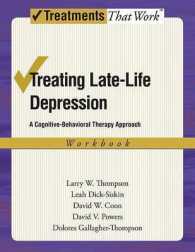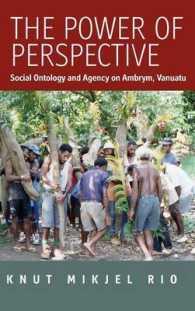- ホーム
- > 洋書
- > 英文書
- > Computer / General
Full Description
Create Amazing 3D Characters with BlenderVideo Compositing Learning Blender walks you through every step of creating an outstanding animated character with the free, open source, 3D software Blender, and then compositing it in a real video using a professional workflow. This is the only Blender tutorial to take you from preproduction to final result, and it's perfect for both 3D novices and those who've used other 3D Software.Focusing on Blender 2.71 and above, 3D-professional Oliver Villar explains all the basics, including Blender's interface, controls, and how to manipulate objects. Once you've mastered the fundamentals, you'll follow a realistic 3D workflow through a complete project.You'll find chapters on every aspect of the character creation: design, modeling, unwrapping, texturing, shading, rigging, and animation. Once your character is ready and animated, you'll learn how to integrate it into a real video using camera tracking techniques, lighting, and compositing. Each skillset is taught hands on, and available online video tutorials (more than 5 hours) will guide you through Blender's trickier tasks.By the time you're done, you'll understand how the whole process fits together, and how to use Blender to create outstanding characters for all media. You'll also build strong Blender skills you can apply in any 3D project, whether it involves characters or not.Learn How ToMaster Blender's innovative user interface, navigation, and selection techniquesCreate your first scene with Blender and get comfortable with its core toolsPrepare for projects so they'll go as smoothly as possibleUse modeling tools to create a 3D characterBring your character to life with color, textures, and materialsCreate your character's skeleton and make it walkMake the most of Blender's Camera Tracking toolsAdd lights to your 3D sceneRender with Blender Internal or the powerful new Cycles render engineComposite your 3D character into a real videoSwitch to Blender from 3ds Max, Maya, or XSI11+ Hours of Video InstructionIntroduction to Blender LiveLessons provides a comprehensive overview of Blender, the professional, free, open source software used to make 3D graphics and animation for animated films, visual effects, art interactive applications, and video games. DescriptionBlender Foundation Certified Trainer Oliver Villar starts from scratch, downloading and installing Blender. Then he jumps into the interface and basic controls. Learning how to create and manipulate objects is the next step before creating a simple scene to understand the workflow. After that, he goes a little deeper, explaining how to model your own creations and unwrapping and shading in both Blender Render and Cycles. An introduction to rigging and animation gives designers the ability to deform and animate their models. Finally, the rendering and compositing process is explained to show how to achieve the resulting image or video. The course aims to take beginners in a journey through the main basic Blender features to help them understand how 3D works.Skill LevelBeginnerWhat You Will LearnHow to install and run BlenderHow to use the interface and navigate in the 3D sceneHow to create your first 3D sceneHow to use Blender's modeling toolsHow to unwrap, add materials, and apply textures with Blender Render and CyclesHow to use rigging and basic animation toolsHow to light and renderHow to use the node editor for compositing and taking your render to the next levelWho Should Take This CourseDesigners and artists interested in creating 3D still images or animations for marketing, design, or visual effectsCourse RequirementsUnderstanding of using an OS, navigating through folders, and basic usage of a computer.Having a keyboard and a mouse (preferably a keyboard with a numeric pad and a mouse with a middle mouse button).Design and previous 3D knowledge helps, but the course starts from the beginning, so this is not mandatory.Table of ContentsLesson 1: Blender BasicsThis lesson covers how to download and install Blender, use the main interface elements such as areas and editors, and configure Blender with your custom settings.Lesson 2: 3D Navigation and SelectionsLesson 2 shows you how to navigate in your 3D scene, use navigation keyboard shortcuts, and configure the 3D View and object selections.Lesson 3: Creating Your First Scene with BlenderIn this lesson you learn the basic workflow to create your first 3D scene with Blender: creating and transforming objects; adding modifiers, materials, and lights; and rendering the final result. Lesson 4: Advanced Object ManipulationThis lesson explains how to transform (move, rotate, and scale) objects using snapping options. It gives you an understanding of datablocks, duplicating and instancing objects, and using pivot points.Lesson 5: Using ModifiersLesson 5 covers the process of adding modifiers to your objects, and you learn about the most-used modifiers and in which cases you can apply them.Lesson 6: Modeling in Edit ModeIn this lesson, you see how to access the different interaction modes, and then you dive into the main modeling tools to create your own 3D meshes and adjust their shapes. Finally, there is a practical exercise to put those modeling tools to good use.Lesson 7: Unwrapping and UVsBefore you can apply textures to a surface, you need to unwrap it and create its UV coordinates. In this lesson, you learn how to use the tools available to do this. You also see how to test those UVs and make sure they work right.Lesson 8: Materials and TexturesThis lesson covers the process of adding materials and textures to 3D objects in both Blender Render and Cycles.Lesson 9: Introduction to RiggingIn this lesson, you learn about armatures and bones, parenting, and constraints. An armature made of bones is what allows you to create a rig that moves your complex objects in an efficient and comfortable way. Also, you see how to deform a mesh based on the bones' movement, useful for posing organic models or characters.Lesson 10: Introduction to AnimationAfter seeing what the different animation editors do, you learn how to set keyframes, add timing to an animation, use animation curves and interpolation, and mix or manage different animations using the NLA Editor.Lesson 11: Rendering in Blender RenderThis lesson shows you how to reach the final resulting image from your 3D scene through the rendering process in Blender Render. For that, you learn how to add lights and configure the render settings.Lesson 12: Rendering in CyclesRendering in Cycles is similar to Blender Render, but there are some substantial changes, and that's why in this lesson you learn about the rendering process and settings for Cycles.Lesson 13: Introduction to CompositingIn this lesson, you learn how to use the Node Editor for compositing. Using nodes, you add the final touches to your render. Things such as color correction, mixing different render layers, and adding effects like a vignette are all possible during nodes compositing, before exporting the final output.About LiveLessons Video TrainingThe LiveLessons Video Training series publishes hundreds of hands-on, expert-led video tutorials covering a wide selection of technology topics designed to teach you the skills you need to succeed. This professional and personal technology video series features world-leading author instructors published by your trusted technology brands: Addison-Wesley, Cisco Press, IBM Press, Pearson IT Certification, Prentice Hall, Sams, and Que. Topics include: IT Certification, Programming, Web Development, Mobile Development, Home and Office Technologies, Business and Management, and more. View all LiveLessons on InformIT at: http://www.informit.com/livelessons
Contents
Learning Blender TOCIntroductionPart 1. Getting Used to Blender1. The UI2. Exploring the BasicsPart 2. Creating a Character3. Full Project Overview4. Character Design5. Modeling6. Unwrapping7. Texturing8. Shading9. Rigging10. Animating11. Lighting12. RenderingPart 3. Finishing the Project13. Camera Tracking14. Lighting Adjustment15. Render Layers and Scene Setup16. Compositing17. Other Features Introduction to Blender LiveLessons TOCLesson 1: Blender BasicsThis lesson covers how to download and install Blender, use the main interface elements such as areas and editors, and configure Blender with your custom settings.Lesson 2: 3D Navigation and SelectionsLesson 2 shows you how to navigate in your 3D scene, use navigation keyboard shortcuts, and configure the 3D View and object selections.Lesson 3: Creating Your First Scene with BlenderIn this lesson you learn the basic workflow to create your first 3D scene with Blender: creating and transforming objects; adding modifiers, materials, and lights; and rendering the final result. Lesson 4: Advanced Object ManipulationThis lesson explains how to transform (move, rotate, and scale) objects using snapping options. It gives you an understanding of datablocks, duplicating and instancing objects, and using pivot points.Lesson 5: Using ModifiersLesson 5 covers the process of adding modifiers to your objects, and you learn about the most-used modifiers and in which cases you can apply them.Lesson 6: Modeling in Edit ModeIn this lesson, you see how to access the different interaction modes, and then you dive into the main modeling tools to create your own 3D meshes and adjust their shapes. Finally, there is a practical exercise to put those modeling tools to good use.Lesson 7: Unwrapping and UVsBefore you can apply textures to a surface, you need to unwrap it and create its UV coordinates. In this lesson, you learn how to use the tools available to do this. You also see how to test those UVs and make sure they work right.Lesson 8: Materials and TexturesThis lesson covers the process of adding materials and textures to 3D objects in both Blender Render and Cycles.Lesson 9: Introduction to RiggingIn this lesson, you learn about armatures and bones, parenting, and constraints. An armature made of bones is what allows you to create a rig that moves your complex objects in an efficient and comfortable way. Also, you see how to deform a mesh based on the bones' movement, useful for posing organic models or characters.Lesson 10: Introduction to AnimationAfter seeing what the different animation editors do, you learn how to set keyframes, add timing to an animation, use animation curves and interpolation, and mix or manage different animations using the NLA Editor.Lesson 11: Rendering in Blender RenderThis lesson shows you how to reach the final resulting image from your 3D scene through the rendering process in Blender Render. For that, you learn how to add lights and configure the render settings.Lesson 12: Rendering in CyclesRendering in Cycles is similar to Blender Render, but there are some substantial changes, and that's why in this lesson you learn about the rendering process and settings for Cycles.Lesson 13: Introduction to CompositingIn this lesson, you learn how to use the Node Editor for compositing. Using nodes, you add the final touches to your render. Things such as color correction, mixing different render layers, and adding effects like a vignette are all possible during nodes compositing, before exporting the final output.








